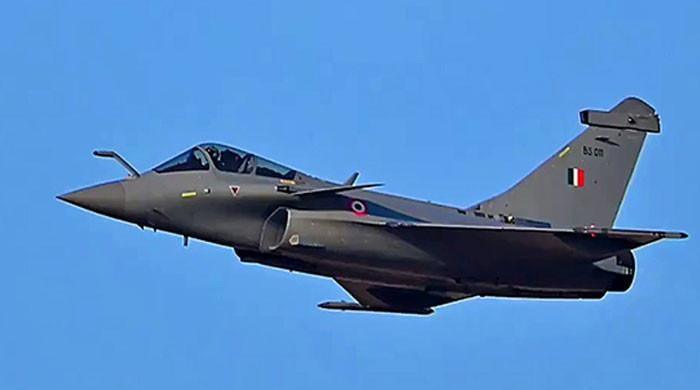- Rafale equipped with 200 km rank weapons approached the border.
- Pakistan blocked the IAF jets, communication, radar sensors.
- PAF J-10C fighters equipped with 230 km of range PL-15 missiles.
From the incident of Pahalgam, India has been trying to provoke Pakistan with her warming and aggressive actions near the border, but Pakistan has been showing moderation and has prevented India from becoming any type of aggression with timely defensive measures.
Due to the effective defensive measures, the Pakistan Air Force (PAF) once again frustrated India’s attempt to move towards Pakistan a few days ago, forcing the modern planes of the Rafale of India to retire.
The PAF frustrated India’s progress at night between April 29 and April 30. According to relevant sources, the PAF took this action on the same night when Federal Information Minister Attaullah Tarar, expressed the fear that India could attack Pakistan in the next 24 to 36 hours.
The sources said that four Rafale Indian planes took off from the Ambala Air Base in the Indian state of Haryana and moved to Pakistan at a land speed of 1,200 kilometers. The Indian plane was very close to the Pakistani airspace, but at no time they crossed it.
However, since these airplanes were equipped with modern Air-Tierra missiles of Spice 2000, which have a range of 200 kilometers, this action of the Indian Air Force (IAF) was a hostile act because the Indian plane could have carried out terrestrial operations in Pakistan while maintaining in its own airspace.
These airplanes flew at an altitude of 40,000 feet when the Pakistan air defense system through its electronic war assets stuck the sensors on board the Rafale aircraft and the communication and radar systems, because these airplanes lost contact with each other and with the ground.
According to the sources, at the same time, the J-10C aircraft of the PAF were also in the air to face the Indian airplanes and avoid any type of aggression. Due to this situation, Indian airplanes had to make an emergency landing in Srinagar instead of returning to Ambala.
It is pertinent to mention here that the Rafale aircraft were equipped with missiles with a 200 km range that night, but J-10c aircraft of the Pakistan Air Force were equipped with PL-15 missiles with a visual range beyond 230 km. This means that the Pakistani plane was also in a position to point to the Indian plane while remained within its own territory.
Relevant sources say that if our air defense system had not struck the communication and radar systems of the Rafale aircraft that night, Indian airplanes could have taken some measures in the Pakistani territory.
Another interesting point to keep in mind is the fact that the Pakistan Air Force took care of the four Rafale aircraft between April 29 and 30 in the same way that it blocked the radar and communication systems of the Indian pilot Abhinandan in 2019. However, at that time the Indian pilot flew an old plane, but this time the Pakistan Air force faced the modern 4.5 generations plane.
According to relevant sources, after facing failure at night between April 29 and April 30, the IAF planned to take measures in Pakistan on Friday.
But as soon as the intelligence of this matter was received, Pakistan immediately had between 40 and 50 aircraft in the air, including F16, J-10C and JF-17. This Pakistan action forced the IAF to abandon its plan.
This means that India has once again faced a setback similar to 2019.
According to relevant sources, the multiple domain capabilities of the Armed Forces, especially the PAF, play an important role in frustrating Indian ambitions. Relevant sources say that the PAF is always one step ahead of India in the fields of electronic, cyber and spatial war. And in the last four or five days, Pakistan made complete use of these modern abilities and took such proactive actions.
Pakistan has frustrated the most advanced Rafale planes in India. India had set high hopes on the Rafale plane in 2019. After 2019, the Indian Prime Minister, Narendra Modi, had admitted his defeat and said that if India had Rafale at that time, the result would have been different.
Now India has Rafale aircraft, but due to the effective operations and modern technology of the PAF, India could not achieve its objectives.
Originally published in the news




